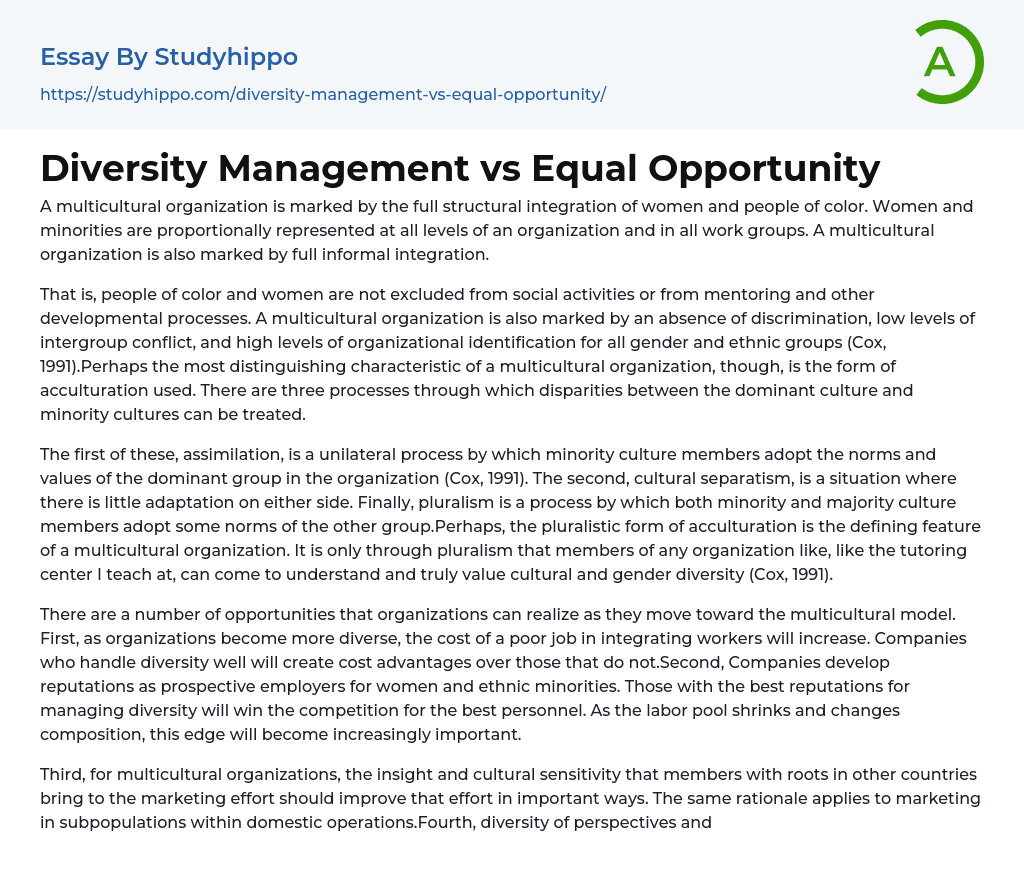A multicultural organization is marked by the full structural integration of women and people of color. Women and minorities are proportionally represented at all levels of an organization and in all work groups. A multicultural organization is also marked by full informal integration.
That is, people of color and women are not excluded from social activities or from mentoring and other developmental processes. A multicultural organization is also marked by an absence of discrimination, low levels of intergroup conflict, and high levels of organizational identification for all gender and ethnic groups (Cox, 1991).Perhaps the most distinguishing characteristic of a multicultural organization, though, is the form of acculturation used. There are three processes through which disparities between the dominant culture and minority cultures can be treated.
The first of these, assimilation, is a unilat
...eral process by which minority culture members adopt the norms and values of the dominant group in the organization (Cox, 1991). The second, cultural separatism, is a situation where there is little adaptation on either side. Finally, pluralism is a process by which both minority and majority culture members adopt some norms of the other group.Perhaps, the pluralistic form of acculturation is the defining feature of a multicultural organization. It is only through pluralism that members of any organization like, like the tutoring center I teach at, can come to understand and truly value cultural and gender diversity (Cox, 1991).
There are a number of opportunities that organizations can realize as they move toward the multicultural model. First, as organizations become more diverse, the cost of a poor job in integrating workers will increase. Companies who handle diversity well will create cost advantages
over those that do not.Second, Companies develop reputations as prospective employers for women and ethnic minorities. Those with the best reputations for managing diversity will win the competition for the best personnel. As the labor pool shrinks and changes composition, this edge will become increasingly important.
Third, for multicultural organizations, the insight and cultural sensitivity that members with roots in other countries bring to the marketing effort should improve that effort in important ways. The same rationale applies to marketing in subpopulations within domestic operations.Fourth, diversity of perspectives and less emphasis on conformity to norms of the past, which characterize the modern approach to management of diversity, should improve the level of creativity. Fifth, heterogeneity in decision-making and problem-solving groups potentially produces better choices through a wide range of perspectives and more critical analysis of issues. And sixth, an implication of the multicultural model for managing diversity is that the system will become less determinant, less standardized, and therefore more fluid.The increased fluidity should create greater flexibility to react to environmental changes (Cox, 1991).
Research and anecdotal evidence exist to support all of these competitive advantages. Several of these competitive advantages have particularly interesting implications in terms of communication within organizations. These are the advantages to be gained through increased creativity and enhanced problem-solving and decision-making, advantages that some communication theorists label as the cognitive consequences of diversity (Cox, 1991).Arguments for increased creativity and enhanced problem solving through diversity both rest on the contention that a diversity of employees will translate into a diversity of viewpoints.
That is, men and women from different ethnic and cultural backgrounds will bring ideas to the organization that would
not be available from a homogeneous workforce of white males. Communication theorists found that innovative companies employed more women and people of color than less innovative companies.Innovative companies also worked to establish heterogeneous work teams in order to create a marketplace of ideas, recognizing that a multiplicity of points of view needs to be brought to bear on a problem (Blake, 1991). Managing these culturally diverse groups poses communicative challenges, however. The advantages of diversity take time and effort.
Specifically, when first formed, diverse groups are inferior to homogeneous groups in both performance and in managing the process of group interaction.However, over time, the diverse groups developed communicative strategies for managing diversity and eventually generated a wider range of alternatives and perspectives on a problem than homogeneous groups. Thus, in order to reap the benefits of diversity, group members should be made aware of their cultural differences and should share core organizational values. The need for heterogeneity, to promote, problem-solving and innovation, must be balanced with the need for organizational coherence and unity of action (Blake, 1991).
In actual fact, the challenges of managing and working in culturally diverse organizations are only beginning to be realized. There are three main challenges that organizations face as the workplace becomes diverse. The first of these is instituting diversity management programs in ways that avoid negative consequences that have been associated with these programs. The second two challenges are associated with gender diversity: the challenges of dealing with sexual harassment and organizational romance in the workplace (Hallock, 2001).
- Leadership and Management essays
- Change Management essays
- Project Management essays
- Knowledge Management essays
- Operations Management essays
- Quality Management essays
- Risk Management essays
- Scientific Management essays
- supply chain management essays
- Performance Management essays
- Time Management essays
- Brand Management essays
- Total Quality Management essays
- Risk essays
- Manager essays
- Leadership essays
- Business Ethics essays
- Board Of Directors essays
- Product Management essays
- Comparative Analysis essays
- Decision Making essays
- Dispute Resolution essays
- Stress Management essays
- Business Management essays
- Brand Equity essays
- Branding essays
- Nike, Inc. essays
- Market share essays
- Razor essays
- Being A Leader essays
- Servant Leadership essays
- Leadership Experience essays
- Leadership Qualities essays
- Incentive essays
- Feminism essays
- Animal Rights essays
- Animal Testing essays
- Bullying essays
- Abortion essays
- Abuse essays
- Immigration essays
- Poverty essays
- Human Rights essays
- Inequality essays
- Violence essays
- Torture essays
- Crash essays
- Assault essays
- Racism essays
- Prejudice essays




